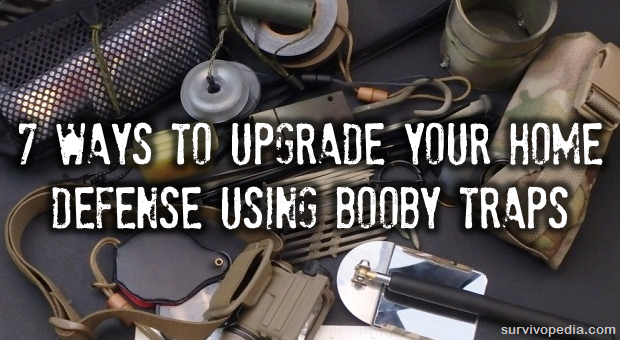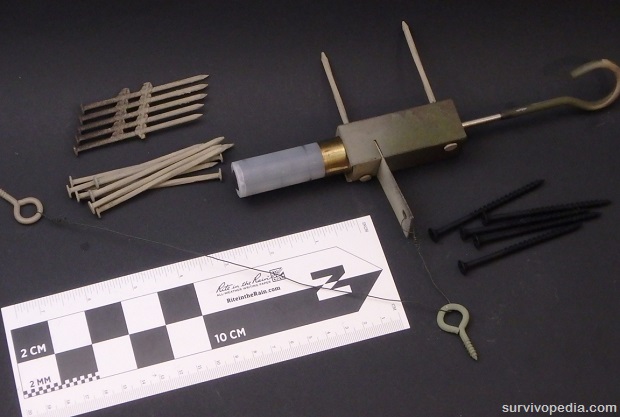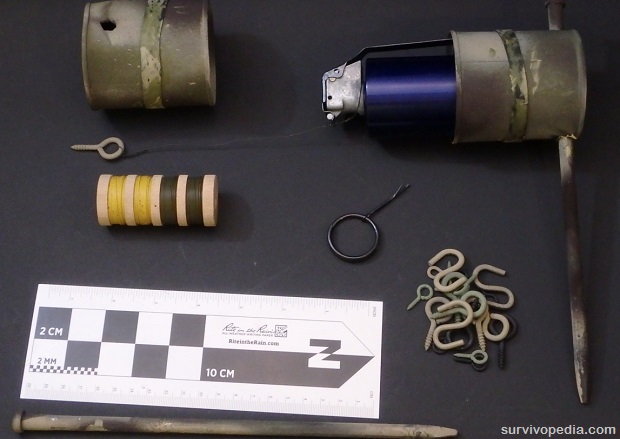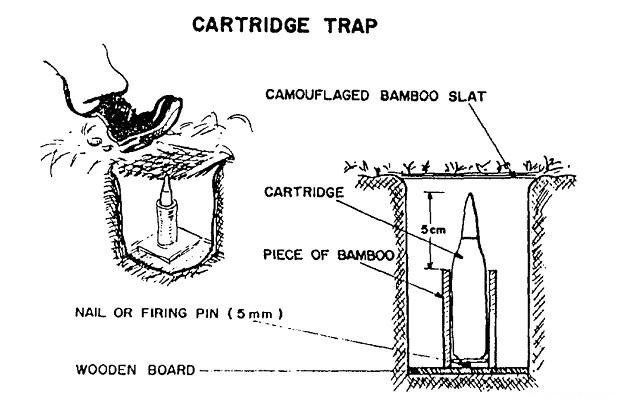Some see the subject of booby traps as taboo. They are mostly those who have been affected by politicians who seek to control the population by controlling the information they access. They do this through fear, suggestion and threat of force.
But I do not believe that the proliferation of information will endanger the good guys. Our society has mechanisms to protect us, chief among them, is the classification of information. I would never pass along classified information, but a far greater threat endangers the average person: ignorance.
The enemies of the common man study and understand booby traps and employ them freely, not just in war. Criminals regularly set booby traps and regular folks stumble into them on the job or in recreational pursuits. Informing regular people about technologies that may be used against them makes them safer as opposed to endangering them.
Among the many hats I have worn, I managed a class A high explosives magazine, hold instructor certifications for a great deal or HE ordnance and have worked both in R&D and in instruction of HE breaching, dynamic entry and EOD. So perhaps a curiosity for things that go boom worked out OK for me, as it lead to me working for the good guys.
Why Should You Learn to Set Booby Traps?
Learning from previous and current military campaigns, when we have sent expeditionary forces into areas where booby traps are used, as many as 65%-75% of casualties they take are caused by booby traps, mines and IEDs, initially. Once troops have had time to become aware of the threat adapt their strategy, tactics and training, this number fell to around 48% … which is still huge! Even trained military personnel have a hard time avoiding booby traps even when aware they are being used.
Why ignore a technology that inflicts more than half of all casualties? It would be a fool’s errand for the average prepper, survival group or guerrilla campaign to stand toe to toe against a well-armed and trained modern military force of any size.
Booby traps give a numerically inferior and under-equipped force a tool to inflict casualties while avoiding direct contact with superior enemy forces. This is especially useful in areas the enemy controls much of the time.
Even rumors of or the appearance of the existence of mines, booby traps or IED’s will often inflict significant psychological effects. This is true whether it be a small group trying to gauge whether or not it is worth the risk to loot or plan a home invasion, or enemy combatants. Suspecting booby traps in an area drastically changes SOP, planning, movement and morale because it will:
- Deny access to key terrain objectives,
- Degrade morale, crushing the enemies resolve and instilling fear in their ranks,
- Slow movement, causing the enemy to slow movement or leave lines of drift altogether,
- Rob the enemy of the element of surprise,
- Buy time to escape or prepare defenses,
- Can be very inexpensive,
- Can be very low tech and improvised largely from resources in your environment,
- Reveal enemy positions, patrols, ambushes, strategy and tactics,
- Avoid direct contact with superior enemy forces,
- They do not have to be lethal to be effective. Less-lethal booby traps will not kill your own people if they slip up, but still serve as a deterrent.
- Inflict casualties, especially of a magnitude decreases unit combat effectiveness. When fighting groups of enemies, it is more effective to cause inflict casualties who need to transported to rear areas, removing multiple litter bearers from battle and requiring substantial treatment, care and medical supplies to treat.
The 12 Principles of Setting Booby Traps
1. Safety
I cannot possibly stress this enough. Booby traps are inherently dangerous. You must follow strict methodology just as with any potentially deadly weapon. Learn from professionals. Do not rely solely on internet articles, books or videos, even if they are created by trained professionals. No one can possibly teach you everything you need to know about this subject in an article.
If you decide to learn this craft, your personal safety is up to you and no one else. The last thing you want to do is to injure or kill yourself or someone you are trying to protect in an attempt to make them safe. Booby traps in peace time have injured first responders responding to structure fires and similar calls, so use good judgement.
They can also kill or injure pets or livestock or be set off by any animal passing through.
2. Legality
It is also up to you to comply with any laws you are subject to. Not all booby traps are lethal, but many types of booby traps and components are strictly regulated relative to licensing of manufacture storage, transport, transfer and use, even less-lethal ones.
Believe me, it is a headache. Learn the law. It is in your best interest to abide by it. You would have a heck of a time trying to convince a judge that setting potentially dangerous or lethal booby traps to prevent theft during peace time passes the reasonable person test.
3. Preparation
Preparation is a double edged sword. Gathering and preparing components ahead of time could lead to their discovery. Future dependent, this could result in some jackbooted thugs shooting you on the spot or charging you with something. If you must gather and prepare components:
- Cache them someplace they will not be discovered or linked to you … or
- Store multi-use items and booby trap components separate from each other and in proximity to unrelated items that constitute a reason to have them. Most well stocked homes have ample material to construct booby traps, but gathering them all together in one pouch or spot makes it simpler for snoops to make associations, i.e. model rocketry motor “starters” with a bunch of model rocketry stuff are far from criminal. But next to a bunch of propellant, shrapnel, fuel, casings, wire, batteries, electrical tape, caulk, tools, etc. and you’re going to raise some eyebrows. It’s all about context.
4. Camouflage
In urban areas, camouflage is usually covert in nature. In the bush, the types of overt camouflage that most people traditionally thing of as camouflage tend to be more useful. Either way, it is less-effective for your enemy to discover the booby trap before he trips it.
Learning to effectively deploy traps for other humans requires study, a devious creativity and loads and loads of dirt time practicing the art. Learning what colors to use in a particular environment and lighting, where to place wires and triggers in the target’s depth and field of vision and what sorts of things will draw his gaze away from what you do not want him to see, all take time and experience to learn to employ effectively.
5. Less Is More
The more apparatus you have to install and the more you disturb the environment, the more likely it is that your trap will be spotted, especially by counter-trackers. But the enemy can’t spot what isn’t there, so keep traps small where possible.
6. SOP
Make sure your group knows where the traps are, where they are not, and what the capabilities of each trap is.
7. Triggers
In addition to being tripped by the target (or anyone else who stumbles onto them) triggers can be triggered electrically, electronically, remotely or on command detonation.
8. Baiting
This technique involves placing spore or items of interest that will attract and distract your prey and are effective when used against someone with an established routine, but are less so against someone who suspects the tactics. Employing them effectively is predicated on knowing your enemy, his routines, training and SOP.
9. Funneling
This technique works great with animals and untrained individuals, but you may have to go to some effort in order for it to not give away your trap to someone trained in the tactic. Anyone with any training will take extra care at road or trail junctions, bridges, fords, gates, choke points, caves or hallways where they know booby traps are likely to be set.
So, if you use typical terrain features, you had better set it just right and have a little luck on your side or your booby trap will get spotted.
10. Lines of Drift
With people, stick to points of destination, objects that get used as part of a routine and lines of drift, similar to how lines of drift are used to set ambushes. When people travel long distances, they rarely leave lines of drift. People get fatigued when traveling long distances, especially while carrying heavy loads. Fatigue leads to soft compromise, soft compromise lead to hard compromise, hard compromise often results in taking casualties or loss of life.
11. Interval
Maintain a 15 meter interval between individual when walking. This way if a booby trap is tripped, you will take fewer casualties. If you trip one, drop prone with the soles of your boots facing the trap to minimize injury if possible. Depending on the fuze they used, there may be enough time.
12. Alertness
Educating yourself and staying alert are your best defenses against booby traps. If your pack is too heavy, you risk becoming a heat casualty or suffering exhaustion. Exhaustion leads to the cycle of compromise explained above.
My advice on staying alert involves rejecting gear-heavy, logistics-dependent models that have you carrying a 120 Lbs. pack. The US Infantry model involves a huge logistics infrastructure of several people in the supply chain for every person in the field. Few preppers can afford to replicate it in any meaningful way. It might work OK for a nation, but infantry squads do not have wives, grandma and a two-year old in tow to worry about. Stick the average prepper in that model and it breaks down in a hurry. Learn the skills, reject the model.
Adopt a less-fragile, more primitive, tribal model. Learn skills so you do not need as much equipment. When traveling, most tribes separate into scout/security and supply elements. The light, fast moving scouts clear the way for the slower moving folks with the gear. Use travois, hand carts, wagons, beasts of burden or vehicles to carry heavy loads instead of your back. Otherwise you will arrive too tired to fight. Rely on supply caches with relatives, friends, friendlies or stashed in the bush for sustainment.
- Stay Alert
- Do Not Rush
- Do Not Carry Too Much Weight
- Do Not Travel Too Far, Too Fast
Equipment
You do not necessarily need a ton of equipment to rig booby traps. Most of the materials you need can be acquired from your environment and your enemy. I am not a big fan of carrying more equipment than necessary, but there are a few, mostly multipurpose essentials that are good to have on hand:
- Trip Line: Use camouflaged wire or low-stretch, hi-strength cordage. Most fishing line really doesn’t work that great, but some of the stronger braided lines in subdued, non-reflective colors can be made to work. You can use this for so many things.
- Flat Spray Paint: Kill shine with a non-reflective base coat that matches your environment. Not something to carry in your pack as much as to knock down shine to prepare equipment unless you know you’ll be trapping, but even then, fresh paint has poor scent discipline.
- EOD Multi-tool: Again, very multi-use and full of useful tools including a cap crimper if you might be doing any of that. Many of these come with a non-ferrous probe kit.
- Hardware: Eye screws, long wood or drywall screws, S-hooks, long nails should be painted flat. They are useful to anchor traps and wires and change the direction of wire.
- 1” Tape: I carry .75” vinyl tape and duct tape or 100mph tape in subdued colors which is extremely multi-use.
- Small EOD Grapnel: A grapnel or the ability to improvise one is used to probe, clear or detonate suspicious objects or wires at a distance and from behind cover, but I would recommend most survivalists flag any suspicious finds and avoid them. If you do decide to trip a trap, don’t forget your hearing protection. Also handy as a weight for hanging bear bags, but you can do that with rocks in a handkerchief which is lighter as long as you acquire the rocks on site as opposed to carrying them with you.
- Telescopic Lighted Inspection Mirror: These are good for up close inspection from behind cover and minimize your chances of tripping a trap. Magnified mirrors help close up, but non-magnified ones pull double duty allowing you to take a peak from behind cover before you turn a corner or make covert entry in a building. Everyone loves to practice dynamic entry, but covert entry tactics are every bit as important for survivalists.
- Light: You need good light to see what you are doing and have any chance of spotting trip wires and spore.
- Grenade Pin or Cotter Pin: If you find a booby trap in place before it is tripped, freeze and warn the rest of your group. Carefully backing out the way you came in (in reverse order) stepping in your tracks is usually your best move. But if you use any munitions with Bouchon fuzes or think you might someday, you might have to safe one. So, you might as well stick a grenade pin in you web gear next time you train. They do not take up much space and if you ever need one, you will really need it. If you do not have one, bend a bobby pin. You should keep a few in your personal survival/recovery kit.
- Apparatus/Ordnance: Any manufactured elements you need to make the booby trap.
- Ear Plugs: You likely carry these already if you shoot much, but working with high explosive ordnance is unimaginably loud and at close proximity it will damage your hearing permanently … even through both plugs and over-ear hearing protection worn simultaneously.
12 Types of Booby Traps You Need to Know How to Build
1. 12ga Trip Trap
Inexpensive and reliable, the idea behind this design is to detonate a 12ga. blank round or flare to alert sentries of intruders, but a little ingenuity and they can easily modified to fire OC rounds, less-lethal impact rounds or even full-house lethal 12 gauge rounds. If you do not know how, you probably should not learn it form an article. If you do, then you do. Placement is key.
2. “Frag In A Can”
In this booby trap, a munition (sometimes more than one) is stuffed in a can to depress the spoon and prevent it from opening far enough to allow the spring-powered striker in the fuze to strike a primer which starts the fuze burning. A tripwire is attached and the safety pin removed. When the wire is disturbed, the munition is pulled from the can, the spoon flies off and the munition goes off. Simple and effective when properly and creatively rigged.
This trap does not have to incorporate a fragmentation munition. Any munition with a Bouchon type fuze will work, but the shorter the delay of the fuze, the better for this application so the M201A1 one second fuzes are good if you have a choice. If you are experienced with these fuzes, you can remove the delay element. You might be thinking “where am I ever going to get one?” In any kind of major disruption, they will come out of the woodwork.
When societies break down, magazines and armories not already cleaned out get looted and munitions and weapons end up in the streets after everyone goes home to take care of their families or are deployed to other areas. In some cases, munitions may repurposed from deceased or captured soldiers, law enforcement officers or anybody who got their hands on them. There are also some pull-fused smoke “grenades” marketed for paintball and Airsoft that can be rigged to work just fine. Scratch fused smoke signals can be used or pyro scratch fuses can also be repurposed.
3. Punji Pit
Essentially a pit trap with the addition of barbed stakes to impale who or whatever blunders into it. Human excrement is sometimes applied to the stakes to promote infection, but could potentially compromise the booby trap due the odor.
4. Fish Hooks
A favorite of narco-criminals protecting drug grows, large treble fishhooks suspended from vegetation by tough, camouflaged line are difficult to spot when well placed. They often dip them in poisons or fecal matter to cause infection. While not immediately lethal, they slow movement and are especially nasty at eye level. Speedhook snares & Mechanical Fisher “yo-yo’s” guarantee a set hook.
5. Rattle Cans
Cans filled with rocks can be suspended with wire so they bounce, are be rigged to make a racket. A stick is often rigged as a flipper, mounted in a few strands of para-cord. The stick is twisted and attached to a trigger and a sere, so when triggered, the stick spins around and beats against a can containing a few pebbles. A little experimentation will give you the noisiest possible rig.
6. Cartridge Trap
In this booby trap, a cartridge is placed in a pit trap with the primer resting on a nail or tack. Better models support the walls of the casing with a short piece of thick-walled pipe of a diameter such that the walls of the cartridge or shot shell casing are supported. Pressure of a footfall pushes the cartridge down onto the tack which fires the cartridge into the foot. It is best to support the firing pin with a board. Elegantly simple, this one.
7. Electronic Booby Traps
A variety of ever-less expensive solutions are available for radio-enabled alarm system components on the high end down to trip-ware actuated alarms with strobes and sirens and simple motion detector lights and sirens on the low end. These can easily be set up as alarms for homes, retreats or camps.
The military now has some amazing programmable booby-traps armed with a terrific suite of sensors, communications and weaponry. They can be networked and remotely armed and disarmed. Why these are not deployed along our borders to aid border patrol is absolutely beyond me.
This article has been written by Cache Valley Prepper for Survivopedia.
bout Cache Valley Prepper
Cache Valley Prepper is a full-time survival and self-defense consultant, instructor and writer, but primarily identifies himself as a lifelong student of survival. He is profoundly grateful to his mentors for afflicting him with an insatiable curiosity about all things self-reliant but claims to be allergic to conspiracy theory. He is a talented competitive shooter, has a profound love of nature, and likes to backpack, camp, hunt and pursue outdoor hobbies. He studies and trains constantly and loves that his work enables him to get in plenty of “dirt time” all over the world … even if it means he has to work a little while he plays. Cache is a volunteer emergency responder in a small town without any paid services and holds numerous instructor and student certifications in everything from emergency management to less-lethal munitions and high explosive breaching. Cache Valley Prepper is a pen name used to protect his identity.









